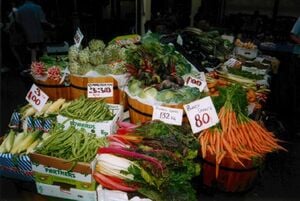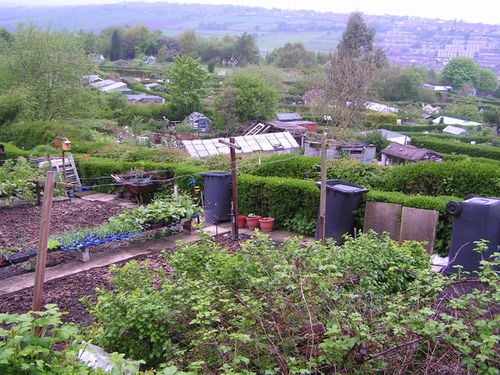
Changing the way food is produced[edit | edit source]
'[We'd like to see] a city area that, through a more joined-up local food-cycle, is able to produce, provide and distribute regenerative sources of healthy and affordable food, supporting the community economy and an inclusive participatory culture.'
MARTYN GOSS Exeter Food Network (A People's Food Policy consultation)
'Our vision of a better food system is one dominated by small-scale mixed farms and food producers working in accordance with agroecological principles and selling most of their food direct to their customers. These food producers not only provide their customers with nutritious food but also give them the chance to connect more directly with their food through educational activities.'
CLARE HORRELL Funding Enlightened Agriculture network (A People's Food Policy consultation)
Our vision[edit | edit source]
Our vision is of a future in which sustainable farming, fishing and horticulture provide healthy food for all, while enhancing the environment, strengthening communities and supporting good livelihoods for farmers, farm workers and fisherfolk.
In this future, there has been a revival in small- and medium-scale farming and food is produced by a mixture of family, community and co-operative farms of different scales using the principles of agroecology. These farms are diverse, mixed, and adapted to the land, culture and territories within which they are embedded.
Farmers have more autonomy from industrial supply chains; inputs are sourced locally where possible; and waste has been minimised by closer integration of livestock, arable farming and horticulture. Agriculture has been integrated with wildlife conservation, and care for soil, water, energy and the climate is at the heart of all food production decisions, while the provision of affordable, nutritious food for local people is its driving force.
GHG emissions have been cut to a third of 2010 levels, due to the uptake of agroecological food production methods, combined with a healthier diet involving less meat and dairy produce and more fruit, vegetables and grains.
Farm animals are well cared for and able to exhibit natural behaviour, resulting in better quality meat, and the overuse of antibiotics in agriculture has been ended. Farms are deeply integrated into their communities, providing nourishment through local markets, opportunities for non-producers to connect with agriculture and nature, and building community in both rural and urban areas.
Community food growing and urban agriculture have expanded in all parts of England, leading to further capacity for people and communities to produce food. Horticulture has expanded to meet demand, creating meaningful and skilled employment. A rigorous fishing policy helps to protect marine environments and fishing livelihoods by focusing on supporting long-term fish stocks and small-scale fisheries.
The case for change[edit | edit source]
The agri-industrial food system today emphasises productivity, profits and competition. It favours consolidation in order to improve competitiveness, at the expense of human health, ecologies, and farmer livelihoods. An alternative model is a multifunctional approach to food production, which would explicitly prioritise outcomes related to healthy diets, environmental sustainability, community development and sustainable farm livelihoods. /40 Pressures on farmers and fisherfolk to industrialise production have been compounded by narrow government policy, the excessive power of supermarkets over the food supply chain and changing diets. Agriculture and fisheries are threatened by a growing number of contradictions that undermine the food system and the integrity of the ecosystems on which it depends.
Agroecology is the application of ecological principles to sustainable agriculture systems.
It is based on the scientific principles of ecology combined with farmers' knowledge and practices. It provides a framework for ecologically, economically and socially regenerative agriculture systems. Agroecology is being developed by farmers around the world to replace the current industrial model of food production and strengthen food sovereignty.
Within its broad umbrella, agroecology includes a wide range of farming techniques and scales, and is supported by a range of social and environmental standards, legislation and economic models. Agroecology enables the autonomy of farmers and communities and rejects the corporate control and manipulation of food for profit.
'Agroecology is political. It requires us to challenge and transform structures of power in society. We need to put the control of seeds, biodiversity, land and territories, waters, knowledge, culture and the commons in the hands of the people who feed the world.' Declaration of the International Forum for Agroecology (2015).
The industrial farming model has led to an ecological crisis in the UK. Increasingly, we are witnessing ecological deterioration in terms of soil depletion, environmental contamination from agrochemicals, disease and antibiotic resistance, biodiversity loss, high GHG emissions, and huge amounts of food waste. More sustainable forms of agricultural production like organic farming have remained marginal, only occupying 2-3% of the total farmed area across the UK. The area of land farmed organically has fallen by 30% from a peak in 2008, /41 despite growing demand for organic products in recent years.[1]
The industrial model has led to a crisis in farm livelihoods. Farming businesses of all sizes are dependent on subsidies (except those under 5 hectares) and non-agricultural sources of income to survive. /42 Today over 50% of farm business income depends on subsidy, /43 and 64% of farmers earn less than £10,000 a year. /44 Between 2014 and 2015 the United Kingdom showed the third largest fall in farm income in the EU with a 19% drop, /45 and farm gate share of retail price has dropped on average 15% between 1988 and 2015. /46
In the UK, the number of farms has declined by around 14% in the last ten years./48 This is mostly due to a sharp decrease in the number of small farms in an ongoing trend of farm consolidation, where small farms no longer considered viable are being folded into larger farms. /49 The concentration of land ownership in England and the price of land per hectare are both among the highest in Europe. /50 This makes it particularly hard for a new generation of farmers – who are desperately needed given that the average age of a farmer in the UK is 59 years /51 – to get access to land and money to start farming.
Small and medium-scale agroecological producers and processors, who offer resilience through diversity and environmental stewardship, are unable to compete with industrial economies of scale despite producing sufficient quantities of nutritious food and multiple social and environmental benefits. The closure of over 30,000 small farms in the UK over the past ten years in particular implies a major loss of skills, knowledge and culture related to farming and food production. /52
The industrial food model has led to a crisis in our diets, contributing to obesity, diet-related disease and malnutrition. There is a fundamental mismatch between agricultural policy and public health priorities. Food policy must take a lead in prioritising production of healthy foods, such as fruit and vegetables, over foods such as sugar, meat and dairy that, when consumed to excess, contribute to disease.
The UK relies heavily on food imports. Just over half of the food eaten in 2016 was produced in the United Kingdom (compared to almost 80% in 1984). /53 Fruit and vegetables are the largest category of food imports into the UK. The UK is currently only 57% self-sufficient in vegetables and 18% self-sufficient in fruit. /54 Some varieties cannot be grown here, but many fruits and most vegetables can. The approach to agricultural policy taken by the UK government has focused on commodity crops, over-reliance on imports (which are often produced under appalling working conditions) and maintenance of low food prices, despite the inevitable negative impacts of this on the livelihoods of farmers and food workers in the UK and worldwide.
Over the last 30 years, land allocated to horticulture production has declined by 25%. /55 This decline has occurred at the same time as public health policy has been promoting the consumption of 'Five a Day'. Rates of fruit and vegetable consumption are far lower than government guidelines, despite recent evidence that high fruit and vegetable intake significantly reduces risk of heart attack, stroke, cancer and early death. While some important work to develop community and urban food growing has already taken place, further support is needed to expand these community initiatives, which provide not only food but also opportunities for social, health and environmental benefits.
The UK produces little of its own organic seed: 85% of organic open pollinated vegetable seeds are currently imported. /56 Globally, just six companies control nearly 60% of the global seed market, and the world's largest seed company – Monsanto – now controls 26% of the seed market. /57
Animal welfare standards have improved but serious concerns remain. Farm assurance schemes' standards vary greatly across the UK. /58 Progress has been made with, for example, the ban on barren battery cages for laying hens and the ban on keeping pregnant sows in narrow stalls. But widespread intensive livestock production (two in every three farm animals are factory farmed) means that animals still have little room to move, are still transported long distances for slaughter, and that antibiotics continue to be overused in farming, despite antibiotic resistance posing a 'catastrophic threat' /59 to human and animal health.
The real solution to this crisis is not to tweak or to conform to the current system, but rather to transform it based on the principles and practices of agroecology. /60 Agroecology is widely practiced around the world /61 and has become part of mainstream global and European policy discourses on food and farming. The report of the International Assessment of Agricultural Knowledge, Science and Technology for Development (IAASTD, 2009) promotes agroecology as a replacement for the industrial model. The French government has taken on agroecology as the main pillar of their food policy. Yet in England, despite the work of the All Party Parliamentary Group on Agroecology (including the draft Agroecology Bill composed in 2014), agroecology is almost completely absent in food policy.
Agroecology is not the same as sustainable intensification, which tends to apply a 'technological fix' approach, while leaving the root causes of the food crisis unexamined. /62 Agroecology is more than a narrow set of technologies, but an entirely different way of organising food and society. While food policy in England has given some attention to organic farming and sustainable intensification, it has done this within the industrial model. Agroecology provides the foundation for a holistic redesign of farming and food in England.
Policy proposals[edit | edit source]
2.1 Promote the use of agroecology[edit | edit source]
- 1.1 The government should support an Agroecology Bill. This was originally proposed by the All Party Parliamentary Group on Agroecology in 2014. /63 This bill would legislate support for a transition to agroecological principles and practices as the basis of farming and food production.
- 1.2 The government should implement a 'human right to seeds and biological diversity'. This would be an addition to the right to food (see policy recommendation 1.1.2), and help to protect and extend people's access to and use of seeds, plants, and animals. /64
- 1.3 Provide economic support for farmers to transition towards agroecology, and support for food workers across the food system where sectors are transitioning to sustainable food practices. This could be achieved through a combination of financial incentives, start-up funding and grants, market supports, and environmental taxes on nonrenewable resources and high-input agricultural systems.
2.2 Increase local food production and consumption[edit | edit source]
- 2.1 Promote local food production on Green Belt and peri-urban land.[2] This could be achieved by identifying underused land and removing planning restrictions for market garden projects and agricultural dwellings, and associated self-build homes and peri-urban smallholdings.
- 2.2 Increase access to local, sustainably produced and fair food in public sector organizations such as schools and hospitals. This could be achieved through procurement policies and buying standards that emphasise provenance and enforce sustainability, welfare and labour standards (see policy recommendations 3.4.2 and 3.9.1).
- 2.3 Local authorities should increase funding for community growing projects. Projects that can demonstrate wider social benefits should be supported to ensure their long-term financial security and sustainability, as many such projects currently rely on volunteers and staff paid low or no wage. Efforts should be made to integrate community horticultural and farming projects with local health and social service contracts.
- 2.4 Develop national planning policies and guidance that support community food growing. This includes training officers in local planning authorities to recognise the benefits of food production projects.
2.3 Increase horticultural production[edit | edit source]
- 3.1 Develop a comprehensive strategy to increase horticultural production based on agroecological farming principles. This should include an infrastructure and investment plan to support growth in the horticultural sector, as well as plans to increase the number of horticultural workers so that domestic production can replace imports. The promotion of agroecological horticulture as a fulfilling career requiring diverse skills would attract more people in England to the sector.
- 3.2 Provide grants and small farm support to new farms and to support farm diversification practices. This should include incentives for current arable farmers to increase horticultural production, as well as incentives to livestock farmers to diversify and move towards more mixed farming models of production (See: A People's Food Policy, Finance for more on grants, subsidies, and support for new farmers).
2.4 Improve animal welfare and reduce environmental impact of livestock farming[edit | edit source]
- 4.1 Introduce rigorous standards for how all livestock are kept, cared for and slaughtered, based on the 'five freedoms' of animal welfare. /65[3] This should include:
- 4.1 (a) Guaranteed humane treatment of all animals on farms, in markets, during transport and at slaughter. This is both for welfare reasons and disease control.
- 4.1 (b) Higher penalties than are currently used, to be applied when conditions and practices do not meet these animal welfare standards.
- 4.1 (c) A moratorium on live export of animals destined for slaughter.
- 4.1 (d) A ban on husbandry systems that do not enable animals to express their natural behaviours. This would include phasing out mega-dairy, battery cage systems and other forms of intensive livestock production. This needs to be part of a wider shift towards less intensive, higher welfare livestock systems.
- 4.2 Prevent the use of 'critically important' antibiotics and ban the prophylactic use of antibiotics on healthy animals. Industrial livestock and fish production systems have become reliant on the overuse of antibiotics, imported animal feed, and low animal welfare standards. Antibiotics are also being overused in human medicine. This overuse in both farming and medicine is resulting in the emergence of antibiotic resistant bacteria, which poses a 'catastrophic threat' to our ability to use antibiotics in the future. /66
- 4.3 Set a target to reduce farm antibiotic use by at least 50% by 2020 and 80% by 2050. This is the target set by the Alliance to Save Our Antibiotics. /67
- 4.4 Support grass-fed and extensive livestock farming systems through grants and subsidies. These grants and subsidies could be offered on a transition basis only, rather than permanently, to encourage a shift from intensive to extensive models of livestock farming.
- 4.5 Limit the import of animal feed produced on deforested land overseas. This could be achieved through the application of tariffs and other import barriers.
- 4.6 Promote growth of UK protein crops as a substitute for imported soy-based feeds. This could include lupins and field beans and would help to diversify crop production and act as a valuable add-in to rotations with leguminous plants.
2.5 Develop a rigorous post-Brexit fisheries policy[edit | edit source]
- 5.1 Set catch limits for all commercial stocks at 'maximum sustainable yield'. These limits relate to scientific advice from the International Council for the Exploration of the Sea. For Europe's shared stocks, this would mean setting limits and agreeing to share catches with other states; for UK stocks, depleted local stocks must be allowed to rebuild to a sustainable level.
- 5.2 Maintain beneficial EU laws that have proven benefits on the marine environment. This includes, for example, the EU's Marine Strategy Framework Directive, which aims to protect marine biodiversity.
- 5.3 Ensure that fishing fleets and associated industries are protected. This should be achieved by: a) supporting the growth of UK markets for UK-landed fish; and b) rebuilding commercial fish stocks to allow catches to increase and boost takings.
- 5.4 Use fisheries policy to support fish stocks long-term and to benefit small-scale fisheries. This particularly applies to the allocation of fishing rights, which have in the past tended to benefit larger-scale fishing companies.
- 5.5 Establish funding to replace the European Maritime and Fisheries Fund. This would help the UK fishing and aquaculture sector transition to sustainable fishing, demonstrate sustainability, and develop domestic markets for UK-landed fish.
- 5.6 Develop government aquaculture standards which progressively adopt the overall principles recently outlined by the Soil Association. /68 These include the sustainable exploitation of fisheries, limited use of chemically synthesised inputs, the exclusion of GM organisms, and respect of regional, environment, climatic, and geographic differences and appropriate practices that have evolved in response to them.
See also[edit | edit source]
External links[edit | edit source]
Notes and references
- ↑ The 2017 Organic Market Report by the Soil Association showed that the UK organic market was in its fifth year of strong growth, with total sales of organic products increasing by 7.1%. /47
- ↑ Local food production needs to be encouraged, but it is not a panacea. As a general principle, the UK should aim to be producing the majority of the food products which can be produced in this climate to ensure a measure of self-sufficiency in food.
- ↑ The Animal Welfare Act 2006 has not been effective at addressing the appalling conditions of animals in factory farms.

